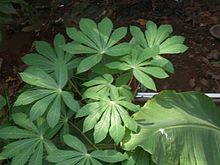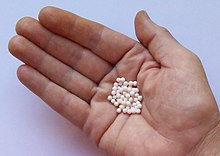Tapioca is a starch extracted from cassava root (Manihot esculenta). This species is native to the North Region of Brazil, but spread throughout the South American continent. The plant was carried by Portuguese and Spanish explorers to most of the West Indies, and continents of Africa and Asia, including the Philippines and Taiwan. It is now cultivated worldwide.
Production
Tapioca is one of the purest forms of starch food, and the production varies from region to region.The cassava plant has either red or green branches with blue spindles on them. The root of the green-branched variant requires treatment to remove linamarin, a cyanogenic glycoside occurring naturally in the plant, which otherwise may be converted into cyanide. Konzo (also called mantakassa) is a paralytic disease associated with several weeks of almost exclusive consumption of insufficiently processed bitter cassava.
Tapioca predominantly consists of carbohydrates, with each cup containing 23.9 grams for a total of 105 calories; it is low in saturated fat, protein and sodium. It has no significant essential vitamins or dietary minerals. One serving of tapioca pudding contains no dietary fiber, a small amount of oleic acid, and no omega-3 or omega-6 fatty acids.
- Wikipedia
Production
Tapioca is one of the purest forms of starch food, and the production varies from region to region.The cassava plant has either red or green branches with blue spindles on them. The root of the green-branched variant requires treatment to remove linamarin, a cyanogenic glycoside occurring naturally in the plant, which otherwise may be converted into cyanide. Konzo (also called mantakassa) is a paralytic disease associated with several weeks of almost exclusive consumption of insufficiently processed bitter cassava.
Commercially, the starch is processed into several forms: hot soluble powder, meal, pre-cooked fine/coarse flakes, rectangular sticks, and spherical "pearls". Pearls are the most widely available shape; sizes range from about 1 mm to 8 mm in diameter, with 2–3 mm being the most common.
Flakes, sticks, and pearls must be soaked well before cooking, in order to rehydrate, absorbing water up to twice their volume. After rehydration, tapioca products become leathery and swollen. Processed tapioca is usually white, but sticks and pearls may be colored. Since old times, the most common color applied to tapioca has been brown, but recently pastel colors have been available. Tapioca pearls are generally opaque when raw, but become translucent when cooked in boiling water.
Nutritional ValueTapioca predominantly consists of carbohydrates, with each cup containing 23.9 grams for a total of 105 calories; it is low in saturated fat, protein and sodium. It has no significant essential vitamins or dietary minerals. One serving of tapioca pudding contains no dietary fiber, a small amount of oleic acid, and no omega-3 or omega-6 fatty acids.
- Wikipedia










No comments:
Post a Comment